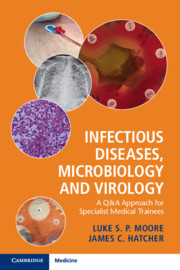Book contents
- Infectious Diseases, Microbiology and Virology
- Infectious Diseases, Microbiology and Virology
- Copyright page
- Contents
- Preface
- Reference Ranges
- Abbreviations
- Chapter 1 Biology of Bacteria, Viruses, Fungi and Parasites and the Host–Pathogen Interactions
- Chapter 2 Microbiology and Virology Laboratory Practice
- Chapter 3 Health and Safety for Infectious Diseases, Microbiology and Virology
- Chapter 4 Principles of Public Health in Relation to Infectious Diseases, Microbiology and Virology
- Chapter 5 Infection Prevention and Control
- Chapter 6 Important Clinical Syndromes Presenting from the Community and within Healthcare Organisations
- Chapter 7 Understanding the Use of Antimicrobial Agents
- Chapter 8 Vaccination
- Chapter 9 The Management of HIV Infection, Opportunistic Infections and Complications of Other Causes of Immunocompromise
- Chapter 10 Travel and Geographical Health; Imported Infection and the Provision of Pre-travel Health Advice
- Index
- References
Chapter 9 - The Management of HIV Infection, Opportunistic Infections and Complications of Other Causes of Immunocompromise
Published online by Cambridge University Press: 19 December 2019
- Infectious Diseases, Microbiology and Virology
- Infectious Diseases, Microbiology and Virology
- Copyright page
- Contents
- Preface
- Reference Ranges
- Abbreviations
- Chapter 1 Biology of Bacteria, Viruses, Fungi and Parasites and the Host–Pathogen Interactions
- Chapter 2 Microbiology and Virology Laboratory Practice
- Chapter 3 Health and Safety for Infectious Diseases, Microbiology and Virology
- Chapter 4 Principles of Public Health in Relation to Infectious Diseases, Microbiology and Virology
- Chapter 5 Infection Prevention and Control
- Chapter 6 Important Clinical Syndromes Presenting from the Community and within Healthcare Organisations
- Chapter 7 Understanding the Use of Antimicrobial Agents
- Chapter 8 Vaccination
- Chapter 9 The Management of HIV Infection, Opportunistic Infections and Complications of Other Causes of Immunocompromise
- Chapter 10 Travel and Geographical Health; Imported Infection and the Provision of Pre-travel Health Advice
- Index
- References
Summary
Patients living with human immunodeficiency virus (HIV) have particular health needs relating to their diagnosis, the opportunistic infections which can affect them, and the chronic disease management of their condition which is impacted by the disease process itself and the medication used to control it. Practitioners working with patients living with human immunodeficiency virus must hold knowledge of the pathophysiology and natural history of the disease, the therapeutic options available for virological control and the likely complication from HIV and the medications. Practitioners must be able to safely monitor and interpret the test results of patients living with human immunodeficiency virus. They must also be able to advise on strategies to decrease onwards transmission of HIV, including pre-and post-exposure prophylaxis. Practitioners managing patients living with human immunodeficiency virus must be able to identify and treat the opportunistic infections which may arise.
- Type
- Chapter
- Information
- Infectious Diseases, Microbiology and VirologyA Q&A Approach for Specialist Medical Trainees, pp. 187 - 209Publisher: Cambridge University PressPrint publication year: 2019



